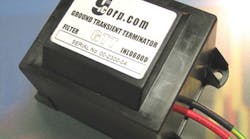Whether you want to believe it or not, your ground wire is betraying you. Sure, it protects your building's electrical system by escorting ground faults out, but it may be letting harmful ground transients in when you're not looking. In fact, your ground wire is an open door to all kinds of runaway electrostatic energy, including nearby lightning strikes, and any sensitive upstream electronic equipment you have will bear the brunt of an intrusion.
The need for continuity to ground and a lack of filtering strong enough to stop ground transients made it impossible to deal with the problem — until engineers at 9 Corp. and manufacturing partner ECM Electronics came across a solution that originated under the hood of a car.
After nearly a decade of developing custom core materials for automotive power inductors, Dan Weaver and other engineers at ECM hit upon a hybrid ferrite mixture that could be tweaked and used to filter out ground transients on electrical systems. “We had a whole different design area open up to us on the back end,” Weaver says.
Finding the right core material was only half of the problem; finding a way to use it was difficult as well. In the past, installing a surge suppressor on the ground wire was out of the question because it could fail and create the potential for a floating ground — a situation more dangerous than downtime.
So instead of taking the standard surge suppressor approach and building the device around an MOV, gas discharge tube, or avalanche diodes, 9 Corp. and ECM developed a filtration circuit that prevented parts from wearing out or failing, making it possible to install the device safely in series with the ground wire. The design earned UL's stamp of approval. “There are no circuits to go through, so the path can't be broken,” says Lloyd DeShane, managing director of 9 Corp.
The GTT is already making ground transient interventions of the divine variety. For two months earlier this year, the security alarm at Christ's Church of the Valley in Peoria, Ariz., fell off line almost daily, and the culprits were ground transients from an unidentified source. Assistant Pastor Kevin Yoakum didn't need to receive many 2 a.m. phone calls from the security company to decide something needed to be done. On the recommendation of a member of the church who also happens to work for 9 Corp., he gave the GTT a shot, and as soon as the church's senior engineer installed it, the early morning phone calls stopped. “We were ready to take the whole security system out and start over, but we didn't have to,” Yoakum says. “I'm a pastor, so I can't tell you how the device stopped our problems, but I can tell you it did.”
For more information, visit www.9corp.com.
How Does it Work?
Like a Roach Motel in reverse, transients check out, but they don't check back in. When runaway high voltage finds its way on to a ground wire, the GTT intercepts it, puts it through two filtering stages, and slows it down until it's a harmless, gradual rise. “Effectively, it's a tuned continuous attenuation circuit configured to filter across a wide bandwidth,” Weaver says.
Stage one — The GTT employs continuous attenuator technology for the first stage of transient taming (Figure at right). As a transient enters this filter, it adjusts to the size of the surge and filters it accordingly. (Frequencies eliminated: 50 kHz to 100 MHz)
Stage two — What's left of the transient moves on to the high-frequency filter, which removes the high-frequency ripple. (Frequencies eliminated: 75 MHz to 300 MHz)
Stage three — The transient leaves the device, broken and beaten. Weaver says it's the combination of filters that makes the process possible. “The problem with ground transients is that you have to be very specific,” he says. “But now we have a filter that covers a wide enough range to get rid of the events that cause problems.”





